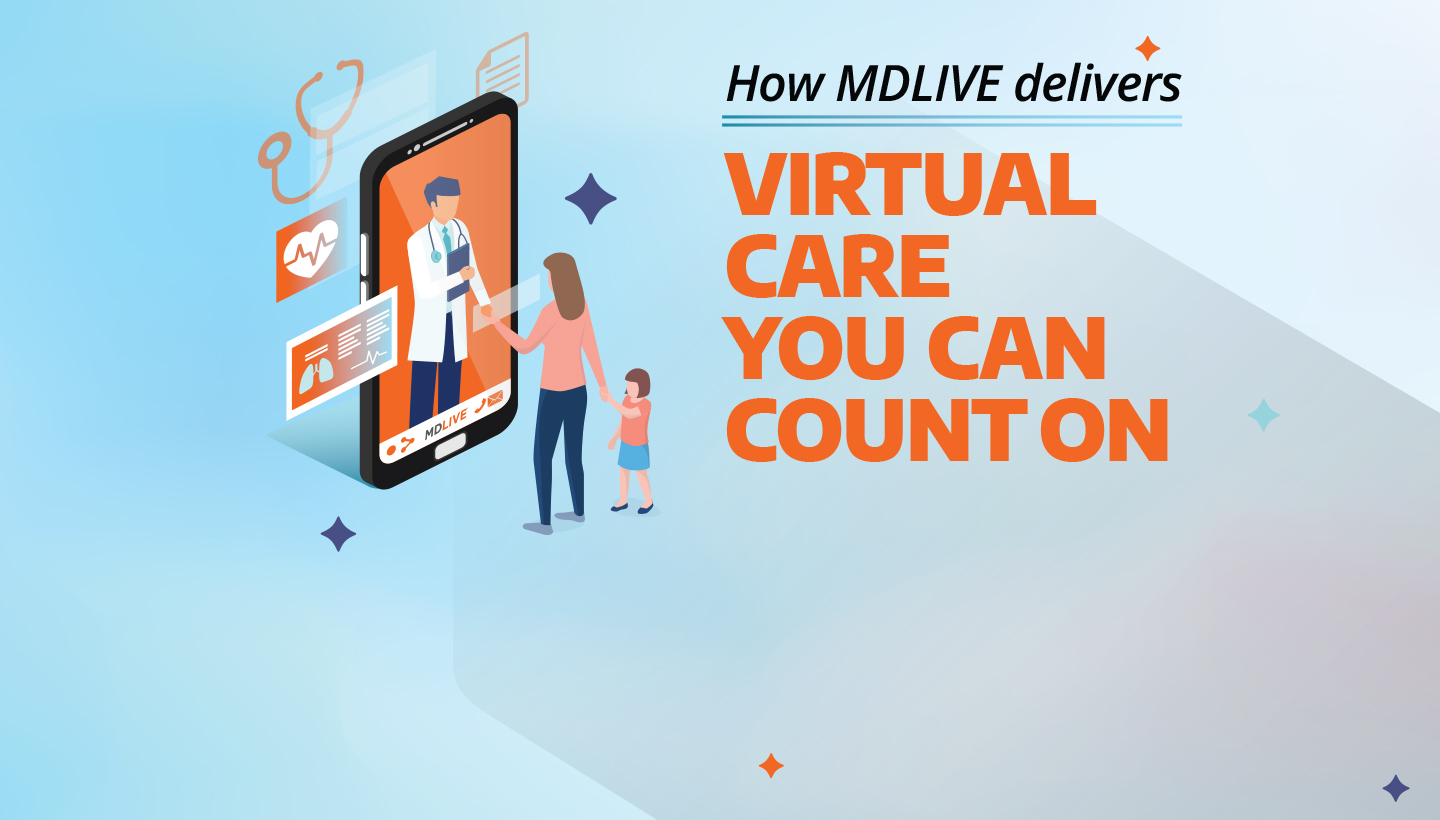
how MDLIVE delivers virtual care you can count on.
Telehealth is a fast and convenient option for health care, but many people wonder if they can get a reliable diagnosis and treatment plan through a virtual visit. In fact, our research suggests 25% of patients have hesitations about the accuracy of telemedicine.
We know the stakes are high when you or a loved one is sick, so our entire team at MDLIVE is dedicated to delivering fast and reliable virtual care. Interested in how we do it? Keep reading to find out – we’ll try to keep the medical jargon in check.
Our five part formula for reliable virtual care.
“I have been a physician for more than 15 years, and whether I’m seeing a patient through video or face to face the commitment to provide excellent care is always my highest priority.”
- Dr. Richard Schneider
How we diagnose our most common conditions.
At MDLIVE, we treat over 80 common conditions across millions of patients through telehealth. Let’s take a closer look at how we use the techniques discussed above to diagnose four of the most common conditions we see: Influenza, Pink Eye, Strep Throat, and Urinary Tract Infections.
Everyone should get an annual flu shot to reduce the risk of catching influenza. However, even if you do get your flu shot, there’s still a chance you could come down with the flu. During the 2018-2019 season, the flu caused about 40 million illnesses in the U.S. according to data from the Centers for Disease Control and Prevention (CDC).
Rapid onset of symptoms like chills, fatigue, cough, and muscle aches are all associated with influenza. A fever often accompanies influenza, so providing your temperature during your MDLIVE telehealth visit helps our doctors arrive at an accurate diagnosis. In fact, according to the CDC, diagnosing the flu based on symptoms like cough and fever is 79-88% effective during the flu season. In contrast, rapid influenza testing (a swab of the cheek) is just 50-70% and can unnecessarily slow down treatment.
Because influenza is so contagious, if you’ve had close contact with someone that has a confirmed case of the flu, our doctors can evaluate you for post-exposure treatment, even if you may not currently have flu symptoms. This is especially important for high-risk patients, including pregnant women and those over 65.
Pink eye might seem like a straightforward diagnosis, but it’s more complicated than you think. Pink eye can be bacterial, viral, or caused by allergies, and your treatment will vary depending on which type you have.
Uploading a clear image of your affected eye(s) will help your doctor determine the cause of your infection and recommend a treatment plan. Symptoms of conjunctivitis include red itchy eyes, watery or colored discharge, a gritty sensation, and overall eye irritation. While most cases can be handled through a telehealth setting, cases with severe eye pain or impaired vision will be directed to an in-person care setting.
Strep Throat, clinically referred to as Streptococcal Pharyngitis, causes 5-15% of the 11 million pharyngitis (sore throat) cases in the U.S. every year. To diagnose strep throat, our doctors will look for common symptoms like a sore throat without a cough, elevated temperature, and swollen tonsils. A clear picture can help your doctor diagnose strep, which is often accompanied by white spots on the back of the throat.
Our clinical guidelines for virtual diagnosis include the Centor rule – a commonly used method that assesses the probability of Streptococcal Pharyngitis based on the presence of key symptoms in combination with a patient’s age. Your doctor will often ask about any recent exposure to confirmed cases of strep throat as the last step before determining your diagnosis and treatment plan.
Our MDLIVE doctors diagnose urinary tract infections in the virtual setting for adult women who are not pregnant. Urinary tract infections in children, men, and pregnant women are more difficult to diagnose virtually, and Sophie, our A.I. powered chatbot, will direct these patients to in-person care instead of a virtual doctor visit.
Painful, frequent urination and blood in the urine are common symptoms of urinary tract infections. For adult women, the presence of key symptoms indicates a 90% probability of a urinary tract infection, enabling a confident virtual diagnosis. Our doctors will discuss the frequency and severity of your symptoms and provide an appropriate treatment plan, which may include antibiotics.
High-quality care, highly recommended.
So what does this all add up to? Fast and accurate virtual care for you and your family, all from the comfort of your home! That’s why 9 out of 10 MDLIVE patients recommend us to family and friends and why more than 40 million people have MDLIVE as part of their health insurance benefits.
Register your account today, and the next time you or someone in your family is under the weather, use MDLIVE for fast virtual care you can count on.
Posted date: March 06, 2020



